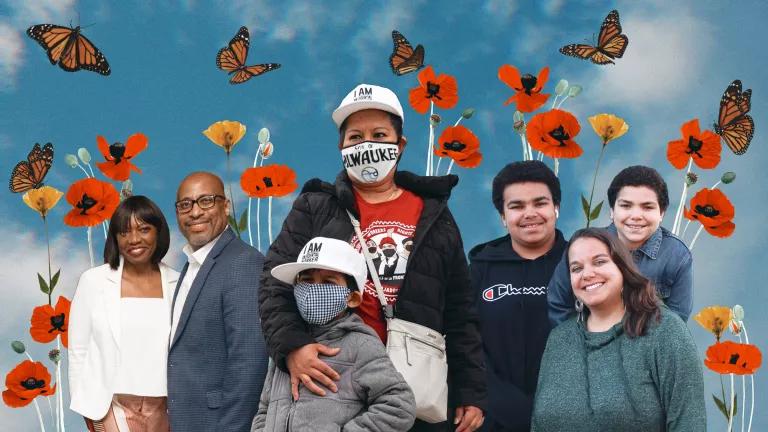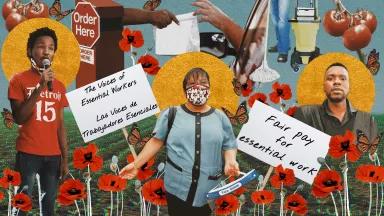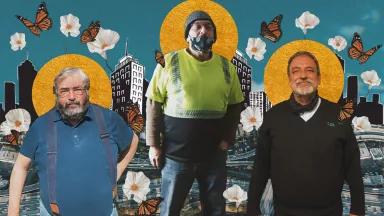From Unemployment to Staff Shortages, This Is What a K-Shaped Recovery Looks Like
In Part Four of our “Pandemic at Work” series, two small-business owners, an office manager, and an undocumented meatpacking employee share where the last 15 months have left them.

The “Pandemic at Work” series explores the work environment in the era of COVID-19 through the voices of those trying to survive through it.
As COVID-19 infection rates ebb while vaccination rates rise, and as states loosen business restrictions, there’s a feeling of hope in the air.
Job growth is up for the sixth straight month, according to the latest labor report, with private sector payrolls at their second highest since March 2020, and the U.S. unemployment rate came in at 5.9 percent for June, down from its pandemic peak of 14.8 percent. Still, the country has a long way to go to escape the COVID-19 recession.
Compared to February of last year, there are about 7 million U.S. workers who are unemployed, nearly 40 percent of whom have been out of work for six months or longer. The official stats, however, don’t account for undocumented workers and those who have stopped looking for employment, withdrawing from the U.S. workforce. Continued childcare and schooling challenges, meager pay and hours, and fear of contracting the virus are contributing to worker shortages in many already hard-hit sectors, such as manufacturing, service, and hospitality, while small businesses struggle to raise wages in order to attract and retain staff.
Economists say signs are currently pointing to what’s called a K-shaped recovery—when the financial trend lines of some segments of the population move in an upward trajectory, while those of other groups continue to slope downward.
From infection and death rates to income and job losses, COVID-19 exposed and exacerbated long-standing inequities in our society. Low-income and BIPOC workers, along with women, undocumented immigrants, young people, and those without a high school diploma bore the brunt of the virus’s economic fallout. And this pattern is likely to mark the pandemic’s aftermath as well.
Federal stimulus aid from the $1.9 trillion American Rescue Plan passed by President Joe Biden in March sought to address those gaps and fuel consumer spending. For longer-term progress, the administration is now fighting to implement its American Jobs Plan, a blueprint for bolstering the nation’s infrastructure in order to support a more equitable economy and create millions of jobs, all while mitigating the climate crisis.
In Part One of this series, essential workers spoke of their anxieties concerning long-term unemployment, safety, and financial stress. Part Two introduced us to undocumented workers who have struggled for acknowledgement of their families and communities in the crisis, and Part Three featured transportation workers navigating the challenges of trying to stay safe while helping to keep “the cogs of society rolling.”
Here, in the series’ final installment, two small-business owners, an office employee, and a laid-off factory worker share stories of survival and feelings of apprehension as a K-shaped recovery speeds up.
MaryAnn and Reginald Marsh, Illinois
In 2019, two longtime entertainment proprietors in Chicago signed the contract on the space for their first restaurant, with an eye toward opening the following year. Then COVID-19 hit.
“Not only did those plans come to a screeching halt, so did business at our two existing venues,” says MaryAnn Marsh, who together with her husband, Reginald, owns the 15-year-old M Lounge, a jazz club, and three-year-old Per.so.na nightclub, both in the South Loop neighborhood.
“It wasn’t as if we could say, ‘OK, never mind.’ We’d invested a huge chunk of our savings as well as investor funds by the time the world went into lockdown,” she says. “We simply had to wait, continue the build-out when we were able, and just pray we could survive until the economy—and eating out—could return at some point.”
And survive the Marshes did, despite suffering financial losses from their two intermittently shuttered and heavily restricted clubs while they continued to pay rent and a chef’s salary for a restaurant that had yet to open. But many around them found it impossible to stay afloat.
“We’re very, very saddened to have lost a lot of local businesses, and primarily our fellow Black-owned businesses,” says Reginald Marsh. “Many of them had to shut down.”
A National Bureau of Economic Research paper published last July found that by May 2020, when states began re-opening after initial lockdowns, 26 percent of Black-owned businesses had closed since February, compared with 11 percent of white-owned and 9 percent of Latino-owned businesses. Following close behind at 25 percent and 21 percent were the extended shutterings of immigrant- and Asian-owned businesses, respectively.
According to the Small Business Majority, an advocacy organization working to empower diverse groups of entrepreneurs, businesses owned by people of color were less likely to acquire federal relief, such as Paycheck Protection Program (PPP) loans, and if they did, were also less likely to receive the amount they requested. A report released by the group in April states, “Entrepreneurs of color faced systemic barriers accessing PPP because the program relies on our traditional banking system that favors well-heeled businesses over smaller, women- and minority-owned firms.” While adjustments to the program led to more equitable distribution of PPP funds over time, the aid was often too little, too late.
Reginald Marsh says he and his wife spent 15 years building a strong foundation for their businesses and were fortunate to qualify for PPP for the M Lounge. “We were able to hold on. But we do hear stories and are saddened to talk to some of our friends who had businesses and were not able to get that funding,” he says. “Some of us just weren’t prepared for such a long drought, weren’t prepared for a pandemic.”
After being one the hardest-hit job sectors earlier in the pandemic, leisure and hospitality was among the top performers in the May labor market. Nearly two-thirds of the new positions in the sector came from restaurants and bars, which remain understaffed and now compete for a diminished pool of applicants—just as their customers begin to return.
“We had a lot of trouble attracting our old employees to come back, and even new ones,” notes MaryAnn Marsh. “A lot of people in our industry are blaming employees for not coming back, but listen, we are back at a reduced occupancy, at reduced hours, so we know we can’t offer living wages to these employees.”
She says the pandemic has taught them to survive with half the number of employees. “I’m not sure if that’s good for them or good for us, but it has caused us to make do and push forward.” On April 28, the Marshes celebrated the grand opening of the Park Supper Club, a restaurant and event space in the historic Washington Park neighborhood.
“Chicagoans are ready to get out,” says Reginald March. “We’ve seen an abundance of reservations. We have waiting lists, and not just for the new restaurant but for all of our venues. The community’s just anxious for it.”
Liza Ford, Maryland
Liza Ford remembers that Friday in March 2020 when the first impacts of the then-mysterious coronavirus rippled through her community. Her company sent everyone home to work remotely and, in short order, her children’s schools shuttered.
“Things ramped up very quickly. We had to figure out what to do, not only for our office but for all the properties that we managed,” recalls Ford, an office manager for a property management firm in Rockville, Maryland. “Everyone pretty much had laptops, but we needed monitors, and it was just a lot of scrambling to get people situated to work from home. I thought ‘Oh, maybe we’ll be home for two weeks.’ We haven’t been back.”
To keep office operations humming, Ford goes into work twice a week, Wednesdays and Fridays, for a couple of hours. A single mother of two sons—Donovan, 13, in seventh grade, and Lucas, 10, in fourth grade—she, like so many parents nationwide, predominantly women, found herself in a new world of having to accomplish eight hours of work for her employer, while simultaneously supervising children’s schooling.
Ford says she’s had to make sure the boys are paying attention and “not just staring at the computer screen,” which interrupts her work responsibilities. “I don’t know how parents with kindergarteners and younger kids do it,” she says. “My kids are a little bit older, and so thankfully, they were a little bit more self-sufficient with this online learning.”
Indeed, a byproduct of the pandemic has been high numbers of women pushed out of the workforce because of closed schools and daycare centers. Montgomery County Public Schools returned to a hybrid system of in-person and remote classes in February, letting parents opt in or out. For district middle schoolers, that meant in-person classes every other week.
“I decided not to send them back. Thankfully, I am flexible enough that I could continue to stay home with them, and I just felt as though I could leave room for other kids whose parents don’t have as much flexibility as I do,” says Ford. “Also, at that time, I was not vaccinated nor was my mother, and they see her a lot.”
“I also thought it sounded kind of miserable for the kids to be sitting there with masks on all day. And it’s weird, they’ve gotten so used to all the flexibility of schooling from home, like being able to get up and get a snack if they wanted to. For the amount of time left in the school year, it just didn’t seem worth it.”
In early May, her company announced its own phased return to the office would begin June 1. Her sons’ school district let out for summer two weeks later.
“It all seems kind of sudden, which seems silly, because it’s been over a year, but it still seems a little bit sudden. And now, with all the changing guidance about masks, I’m not sure how it will go,” says Ford of balancing her new schedule.
She planned to keep her in-office schedule as light as possible while her boys continued their at-home education, in order to help them stay on task.
“Once summer vacation starts, I won’t be as worried about them being unattended. They’re kind of in a transitional period, because of their ages,” she says. In that respect, Ford is one of the lucky moms who doesn’t have to rely on complicated childcare arrangements to get her family through the next couple of months. “One thing I have noticed with my younger one during this pandemic is his independence has shot off the chart. It’s helped him mature in some ways, so I feel like I don’t have to put him in summer camp. He can just be around the neighborhood.”
Maria Ramirez Vazquez, Wisconsin
When Maria Ramirez Vazquez contracted coronavirus at the meatpacking job she had held for 13 years, the undocumented worker never imagined it was the beginning of a tumultuous journey that finds her still looking for work a year later.
“It’s been an incredibly difficult year for me, my family, and for many immigrant families. Yet, despite the difficulties, I find hope and gratitude, and I'm thankful for the time I can spend with my children,” says Vazquez, who came to the United States with a cousin two decades ago from Mexico, seeking a better life.
The 42-year-old single mother of four was caught in the wave of infections that turned the nation’s meatpacking plants into coronavirus hot spots, with at least 203 workers dying and 42,534 testing positive in 494 plants between March and September last year. During that time, there was little to no oversight by federal regulators.
“I was a machine operator but had done just about every job there, cutting the meat, cleaning it, making burgers, putting them in a machine, packaging them in boxes, loading them on pallets,” says Vazquez. “The worst thing those months was the fear, because this was a small plant, and we were all working together like sheep in pens.”
Vazquez tested positive last April and was homebound fighting the illness for more than a month. She returned to work only to be laid off in July, along with 28 other workers who had been complaining of the lack of personal protective equipment, information on workplace COVID infections, and sick days. The Strauss meat packing company claimed “no-match letters” from the U.S. Social Security Administration for those employees. No matches indicate discrepancies between federal databases and Social Security numbers, though advocates argue such letters have nothing to do with work authorization or immigration status. Vazquez points out she had already worked for the company for 13 years before they decided her lack of a Social Security number was a problem.
Immigrant advocacy group Voces de la Frontera’s Essential Workers Rights Network took up their cause, filing a complaint with the Occupational Safety and Health Administration and negotiating a $264,000 settlement with the company in August. In the end, the workers received four days’ pay for each year they had worked, plus vacation pay.
Since her layoff, though, Vazquez’s job search has been fruitless. “Many places were closed. And if you don’t have documents, it is not easy to get work,” says Vazquez.
By year’s end, the $5,000 settlement Vazquez received after taxes was consumed by the $750 she pays in monthly rent for the three-bedroom apartment she shares with her children, ages 5, 13, 16, and 21. To get by, she has been relying on family, friends, food banks, and programs assisting immigrants.
Now vaccinated, and seeing more businesses re-opening, Vazquez hopes a job is in her near future, as well as a pathway to citizenship. “My only dream is to have documents, so that I can work without discrimination, as happened to me and the others at the plant. Because otherwise they only exploit you, and you work earning a miserable wage.”
She adds, “Immigrant essential workers have been on the frontlines, and we deserve to be recognized for our contributions. I want my children, and all immigrant families, to have the ability to be healthy and to thrive.”
This NRDC.org story is available for online republication by news media outlets or nonprofits under these conditions: The writer(s) must be credited with a byline; you must note prominently that the story was originally published by NRDC.org and link to the original; the story cannot be edited (beyond simple things such as grammar); you can’t resell the story in any form or grant republishing rights to other outlets; you can’t republish our material wholesale or automatically—you need to select stories individually; you can’t republish the photos or graphics on our site without specific permission; you should drop us a note to let us know when you’ve used one of our stories.




The Particulars of PM 2.5
What Is the Justice40 Initiative?
Air Pollution: Everything You Need to Know